Chapter 7: Financial performance measures in the private sector
Chapter learning objectives
Upon completion of this chapter you will be able to:
- demonstrate, for a profit-seeking organisation, why the primary objective of financial performance should be primarily concerned with the benefits to shareholders
- justify, for a profit-seeking organisation, the crucial objectives of survival and business growth
- discuss the appropriateness of, and apply the following as measures of performance:
- return on capital employed (ROCE)
- return on investoment (ROI)
- earnings per share (EPS)
- earnings before interest, tax and depreciation adjustment (EBITDA)
- residual income (RI)
- net present value (NPV)
- internal rate of return and modified internal rate of return (IRR, MIRR)
- economic value added (EVATM)
- discuss why indicators of liquidity and gearing need to considered in conjunction with profitability
- compare and contrast short and long run financial performance and the resulting management issues
- explore the traditional relationship between profits and share value with the long-term profit expectations of the stock market and recent financial performance of new technology/communications companies
- assess the relative financial performance of the organisation compared to appropriate benchmarks.
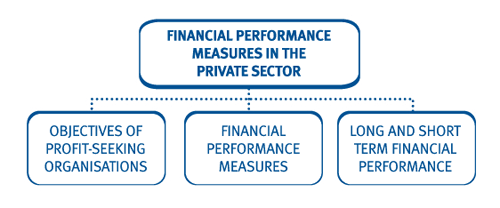
1 Exam focus

2 The objectives of profit-seeking organisations
2.1 Maximising shareholder wealth
- The primary objective of a profit seeking organisation is to maximise shareholder wealth.
- This is based on the argument that shareholders are the legal owners of a company and so their interests should be prioritised.
- Shareholders are generally concerned with the following:
- current earnings
- future earnings
- dividend policy
- relative risk of their investment.
All of these are driven by financial performance.

 Test your understanding 1
Test your understanding 1
What will be the primary objective of a commercial bank? What might be some of its subsidiary or secondary objectives?

2.2 Survival and growth
The objective of wealth maximisation is usually expanded into three sub-objectives:
- to make a profit (see above)
- to continue in existence (survival) - survival is the ultimate measure of success of a business. Without survival then obviously there will be no fulfillment of other objectives. In order to survive in the long-term a business must be financially successful
- to maintain growth and development - growth is generally seen as a sign of success, provided it results in improvements in financial performance.

 Illustration of survival and growth
Illustration of survival and growth
Growth can be identified in a number of ways both financial and non-financial.
Financial:
- profitability
- revenue
- return on investment (ROI)
- cash flow.
Non-financial:
- market share
- number of employees
- number of products.


 Objectives according to Drucker
Objectives according to Drucker
Peter Drucker has suggested that profit-seeking organisations typically have objectives relating to the following:
- market standing
- innovation
- productivity
- physical and financial resources
- profitability
- manager performance and development
- worker performance and attitude
- public responsibility.

2.3 The relationship between profits and shareholder value
Rather than focusing on achieving higher profit levels, companiesare under increasing pressure to look at the long-term value of thebusiness. This is due to the following factors.
- research has suggested a poor correlation between shareholder return and profits
- investors are increasingly looking at long-term value
- reported profits may not be comparable between companies.
While these issues have been known for some time, they have comeinto sharp focus due to the performance of new technology/communicationscompanies.

 Illustration 1 – Profits and shareholder value
Illustration 1 – Profits and shareholder value
Timescales
In calculating shareholder value it is customary to make adistinction between the 'planning' period (usually less than 5 years),and the 'continuing period' beyond. Results for different industriesshow the following:
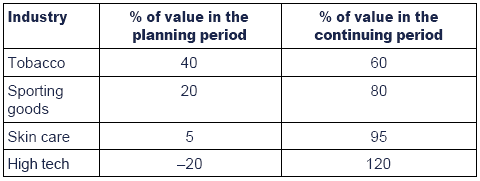


 Shareholder return and profits
Shareholder return and profits
The correlation between shareholder return and profits
Total shareholder return (TSR) is the return shareholders receive both in dividends and capital growth.
Studies have found that there is little correlation between TSR andEPS growth, and virtually no relationship at all with return on equity,yet many companies are still using profit as their only measure ofperformance.
Even where companies state that their objective is to maximiseshareholder value, often directors' bonuses are still based onshort-term profitability or EPS targets.
However strong evidence has been found between shareholder value and future cash flows.

3 Financial performance measures
Financial performance exists at different levels of theorganisation. This chapter is mostly concerned with measuring thefinancial performance of the organisation as a whole, and of measuringthe performance of key projects. Chapter 8 will cover divisionalperformance.

 Performance measures
Performance measures
A good performance measurement system should have the following characteristics:
- Support corporate strategy, its communication and implementation.
- Measure performance from a financial, non-financial, quantitative and qualitative perspective.
- Attuned to the needs of decision makers and their activities.
- Reporting is produced at sufficient regularity to properly support decision-making.
- Attention to the accuracy of data and calculation of measures is important for trust in the information.
Any performance measurement system requires the identification ofindicators which can identify past, current or potential futureoutcomes.
The aim:
- Report past outcomes, both good and bad;
- Identify where improvements should be made and what resources are required;
- Determine the quality and robustness of business processes; and
- Allow stakeholders to independently judge an organisation's performance.
By embodying the key measures that are important for theorganisation strategy they can indicate to the organisation what isimportant. (Often incorporated in strategic frameworks such asscorecards).
NB: As a general rule these measures are only meaningful when compared with:
- other time periods
- other measures of performance
- other companies
- other industries
- budget.

3.1 Return of capital employed (ROCE)
 ROCE is a key measure of profitability. It shows the net profit that is generated from every $1 of assets employed.
ROCE is a key measure of profitability. It shows the net profit that is generated from every $1 of assets employed.
- ROCE is sometimes calculated using PBIT instead of net profit. Use whichever figure is given in the exam.
- Capital employed = total assets less current liabilities or total equity plus long-term debt.
- Capital employed may be based on net book value (NBV), gross book value or replacement cost. Use whichever figure is given in the exam.

Other profitability measures
ROCE is usually calculated as part of a range of profitability measures. Most of these were covered in paper F5 and include:
- Gross profit margin = (Gross profit/Sales) × 100%
- Net profit margin = (Net profit/Sales) × 100%
- Asset turnover = (Sales/Capital employed)
- Dividend cover = (PAT/Dividends paid during the year)
- Dividend yield = (Dividend per share/Current share price) × 100%
- EPS (covered below)
- P/E ratio = (Share price/EPS)
- Earnings yield = (EPS/Share price) × 100%
- EBITDA (covered below)

 Test your understanding 2
Test your understanding 2

For companies A and B, which of the following statements are true?
(1)Company A has a higher ROCE than company B.
(2)Company B has a higher ROCE than company A.
(3)Company A is more profitable than company B.
(4)Company A is better utilising the funds invested in it than company B.
Choose
A1, 3 and 4.
B2 only.
C1 and 4.
DNone of these.

3.2 EPS
 EPS is a measure of the profit attributable to each ordinary share.
EPS is a measure of the profit attributable to each ordinary share.
For EPS to be truly meaningful, it must be set in context.
- Is EPS growing or declining over time?
- Is there likely to be significant dilution of EPS?
- Is it calculated consistently?
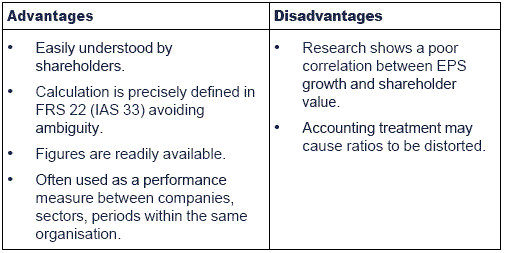

 Test your understanding 3
Test your understanding 3
Overbearing Inc share capital is as follows:

The company made profits before tax of $5,500,000. Corporation tax on this is calculated as $2,100,000
Required:
Calculate the company's EPS.

3.3 EBITDA
 EBITDA is:
EBITDA is:
- earnings before interest, tax and depreciation adjustment or
- earnings before interest, tax, depreciation and amortisation.
The two versions are entirely interchangeable.
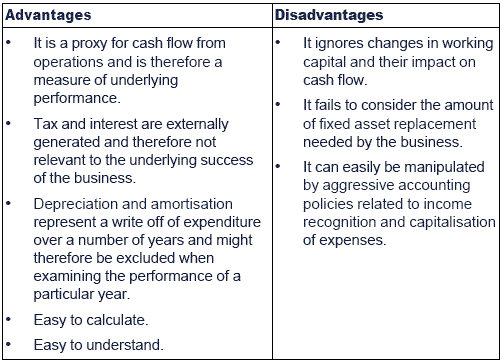
3.4 Net present value (NPV)
 The NPV is the present value (PV) of all cash inflows less the PV of all cash outflows of a project.
The NPV is the present value (PV) of all cash inflows less the PV of all cash outflows of a project.
- NPV represents the increase or decrease in value of an organisation today as a result of accepting the project being reviewed.
- Decision rule: any project that generates a positive NPV is viable.
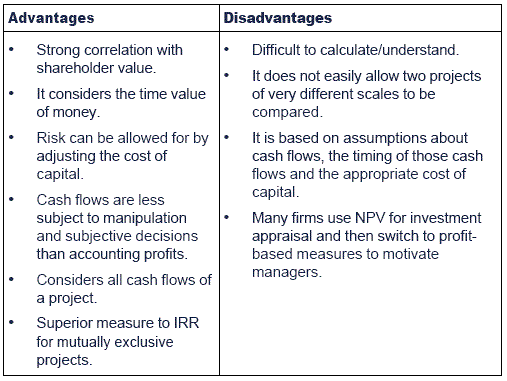

 Test your understanding 4
Test your understanding 4
Oracle Inc invests in a new machine at the beginning of Year 1which costs $15,000. It is hoped that the net cash flows over the nextfive years will correspond to those given in the table below.

(i)Calculate the NPV assuming a 15% cost of capital.
(ii) Calculate the NPV assuming a 10% cost of capital
(iii)Draw a conclusion based on your findings.

Sensitivity analysis
Sensitivity analysis calculates the percentage change in avariable, e.g. sales volume, that would have to occur before theoriginal investment decision is reversed, i.e. the project NPV changesto $0.

Benchmarking
Benchmarking has already been covered in chapter 1. In the exam,you may be required to assess the relative financial performance of anorganisation compared to appropriate benchmarks.

 Test you understanding 5
Test you understanding 5
John Dee Limited (JDL) manufactures a range of solar panel heating.They have recently developed the new EF solar panel. The directors ofJDL recently spent $20,000 on market research, the findings of which ledthem to believe that a market exists for the EF panels
The finance director of JDL has gathered relevant information andprepared the following evaluation relating to the proposed manufactureand sale of the EF solar panels.
(1)Sales are expected to be 2,700 units per annum at a selling price of $3,000 per unit.
(2)Variable material, labour, and overhead costs are estimated at $1,580 per unit.
(3)In addition, a royalty of $250 per unit would be payable to EF (Environmental Friends), for the use of their brand name.
(4)Fixed overheads are estimated at $900,000per annum. These overheads cannot be avoided until the end of the yearin which the EF solar panels is withdrawn from the market.
(5)An initial investment of $7 million would berequired. A government grant equal to 50% of the initial investmentwould be received on the date the investment is made. No tax allowanceswould be available on this initial investment. The estimated life cycleof the EF solar panels is six years.
(6)Corporation tax at the rate of 30% per annum is payable in the year in which profit occurs.
(7)The cost of capital is 12%.
Required:
(a)Calculate the net present value (NPV) ofthe EF solar panels proposal and recommend whether it should beundertaken by the directors of JDL.
(b)Using sensitivity analysis, estimate by whatpercentage each of the under-mentioned items, taken separately, wouldneed to change before the recommendation in (a) above is varied:
(i)Initial outlay of $7,500;
(ii) Annual contribution.
(c)Comment on THREE factors other than NPV thatthe directors of JDL should consider when deciding whether tomanufacture the EF solar panels.
(d)Explain the term 'benchmarking' and brieflydiscuss the potential benefits that JDL can obtain as a result ofundertaking a successful programme of benchmarking.

3.5 Internal rate of return (IRR)
 The IRR is the discount rate when the NPV = 0.
The IRR is the discount rate when the NPV = 0.
where:
L = lower cost of capital
H = higher cost of capital
NPVL= the NPV at the lower cost of capital
NPVH= the NPV at the higher cost of capital
- When presented with uncertainty about the cost of capital, some managers prefer to assess projects by reference to the IRR.
- Decision rule: the project should be accepted if the IRR is greater than the firm's cost of capital.

 Test you understanding 6
Test you understanding 6
A project's predicted cash flows give:
- a NPV of $50,000 at a cost of capital of 10%
- a NPV of ($10,000) at a cost of capital of 15%.
Required:
Calculate the IRR

Question focus: now attempt Q11 from chapter 13.
3.6 Modified internal rate of return (MIRR)
- One drawback of IRR is that it is possible to get multiple rates of return.
- MIRR eliminates this possibility.
 The MIRR represents the actual return generated by a project.
The MIRR represents the actual return generated by a project.
Method:
Step 1: The cash flows after the initial investment areconverted to a single cash inflow at the end of the last year of theproject by assuming that the cash flows are reinvested at the firm'scost of capital.
Step 2: The MIRR is calculated as the return which equatesto the present value of the outflows to this single inflow, usingpresent value tables.

 Illustration 2 - MIRR
Illustration 2 - MIRR
The following information is available for a project:

The cost of capital is 10%.
Required:
Calculate the MIRR of the project.
Solution:
Step 1

Step 2

10,312 × Cost of capital yr 4 @ MIRR = 5,826
Cost of capital yr 4 @ MIRR = 5,826 ÷ 10,312
= 0.565
From tables, MIRR is approximately 15%

3.7 Liquidity and gearing indicators
Liquidity ratios
These ratios measure the ability of the company to meet its short-term obligations:
- Current ratio= Current assets/Current liabilities
- Acid test or quick ratio= (Current assets – inventories)/Current liabilities
- Raw material period= (Ave. value of raw materials/Purchases)×365
- WIP period= (Ave. value of WIP/Cost of sales) × 365
- Finished goods period= (Ave. value of finished goods/Cost of sales)x365
- Receivables period= (Ave. receivables/Sales)×365
- Payables period= (Ave. payables/Purchases)×365
There is often a trade-off between liquidity and profitability.Companies can be highly profitable but get into trouble when they runout of cash (overtrading).
Therefore liquidity needs to be considered alongside profitability when appraising a company's financial situation.
Gearing ratios
These ratios measure the ability of the company to meet its long-term liabilities:
- Gearing = (Long-term debt/Shareholder funds) × 100% or
- Gearing = (Long-term debt/(Long-term debt + Shareholders funds)) × 100%
- Interest cover = (PBIT/Interest charges)

 Test your understanding 7
Test your understanding 7
AK is a privately owned manufacturing company and has been experiencing difficulties.
You have been asked to assess the current position of AK using appropriate performance measures:
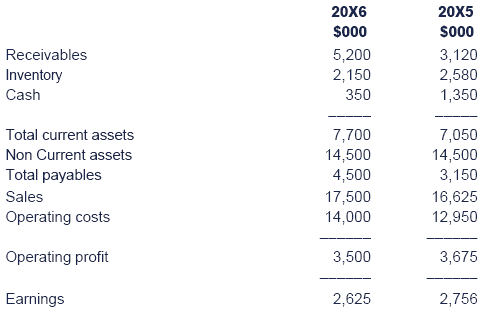
There are 2.5 million share in issue.


 Assessing financial performance
Assessing financial performance
BPG is a Telecommunications company who commenced trading in 20X1through the country of Brean. In 20X6 they established a similardivision in the country of Porlet.
Required:
Assess the financial performance of BPG and its operations in Breanand Portlet during the years ended 20X8 and 20X9. Using the dataprovided below.
Note: you should highlight any information that would be required to make a more comprehensive assessment of financial performance.
Summary Income Statements
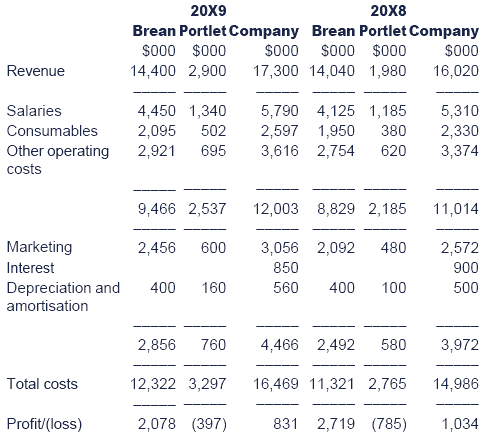
Statement of financial position
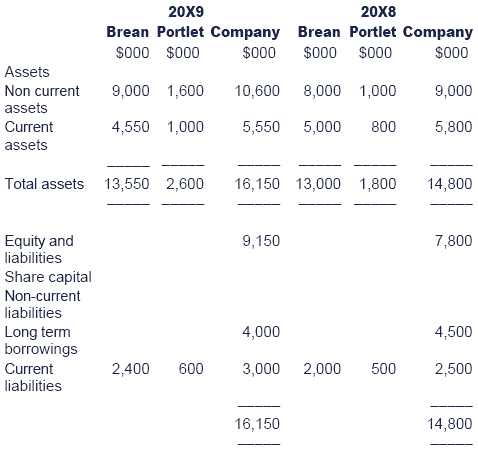
Solution:

The turnover in Brean has increased by 2.6% whilst in Portletturnover has increased by 46.5% which is excellent since the businessonly commenced trading in 20X6. The overall growth amounted to 8% whichis an acceptable level.
The profits in Brean are down by nearly 24% whilst in Portlet theloss has fallen by 49%. Portlet will need to make further growth insales and monitor costs in order to become more profitable.
The costs within Brean have risen by 8% for salaries, 7% formarketing and 6% for operating costs yet sales have only increased by2.6%.
The costs within Portlet have risen substantially more than inBrean. Marketing for example has risen by 32%. This may be due to thefact that this is a necessary cost to develop the growth in revenuewithin the newly established operation.
Salaries and operating costs have risen by between 12 and 13%, yetsales have increased by 46%. These costs should be monitored as thebusiness grows further.
The EBITDA has fallen by 8% from $2,434,000 to $2,241,000 and ROCEhas also fallen from 13.1% to 10.4%. This is not a very good sign forthe company.
The non current asset utilisation ratios of Brean shows a decreasefrom 20X8 to 20X9. Portlet also shows a decrease from 2 to 1.8, this isless surprising given that the operation has only recently beenestablished. Portlet is clearly in a rapid growth phase hence the needfor investment in non-current assets.
It would be useful to have previous years data for Brean to observelonger term trends for revenue and costs. Data for Portlet from itsfirst year of operation in 20X6 would enable a complete picture to betaken.
Competitor information would allow us to establish the market shareand establish how well the operations are performing in comparison tocompetitors.
It is clear that long term borrowings have decreased from 20X8 to20X9 and that BPG has sufficient cash flow to repay some of the debtfinance. However it would be useful to have a breakdown of workingcapital for each operation.
It would also be useful to have future market and financialprojections for Brean and Porlet, which should reflect the actualresults in 20X8 and 20X9.
Budgeted data would be useful to see if they have managed to meet the targets set.
You may be tempted to review the cash flows. This is not requiredin the question and the examiner is unlikely to expect this from you inthis type of question.


 Test your understanding 8
Test your understanding 8
Water Supply Services (WSS) and Enterprise Activities (EA) are twowholly-owned subsidiaries of Aqua Holdings. You have recently qualifiedas an accountant and have joined the finance team of Aqua Holdings atheadquarters. Your finance director is not satisfied with theperformance of these two subsidiaries and has asked you to prepare areport covering the following issues:
(1)The profitability of the two subsidiaries.
(2)The competence of the EA manager to make financial decisions.
(3)The consequences of having a common management information system serving both companies.
The finance director has also provided you with the following background information on the two companies.
WSS
The company holds a licence issued by the government to be the solesupplier of drinking water to a large town. The business necessitates aconsiderable investment in infrastructure assets and is thereforehighly capital intensive. To comply with the licence the company has todemonstrate that it is maintaining guaranteed service standards to itscustomers. WSS is extensively regulated requiring very detailed annualreturns concerning costs, prices, profits and service deliverystandards. The government enforces a price-capping regime and thereforethe company has limited freedom in tariff determination – thegovernment will normally only sanction a price increase following ademonstrable rise in costs.
EA
In contrast to WSS, EAs operates in a very competitive marketoffering a plumbing service to domestic properties. The business has thefollowing characteristics:
- rapidly changing market conditions
- a high rate of new entrants and business failures
- occasional shortages of skilled plumbers
- fluctuating profits.
In addition to this background information you also have summarisedincome statements and balance sheets for the last two years for bothcompanies.
Water Supply Services
Summary income statement

Summary balance sheet (statement of financial position)
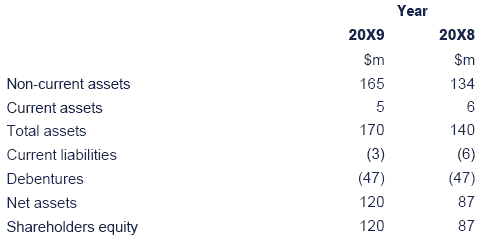
Enterprise activities – summary income statement
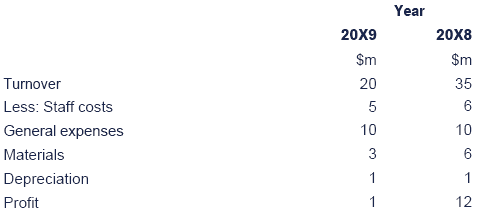
Summary balance sheet
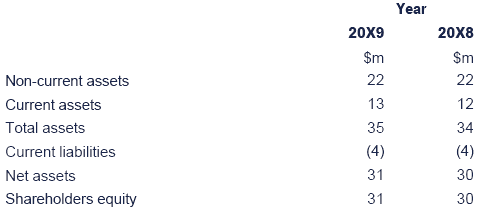
Prepare a report on the comparative financialperformance of Water Supply Services and Enterprise Activities from theabove financial statements. Your report should incorporate an assessmentof the potential limitations of undertaking such a comparison.

4 Short and long-term financial performance
- Short-term financial performance measures are used for:
- control purposes
- determining executive rewards
- assessing the quality of past decisions and assessing the impact of decisions yet to be made.
- However, there is always a danger that longer-term performance can be compromised by pressure to achieve these short-term targets.
Steps to reduce short termism
- Use financial and non-financial measures: these should focus manager's attention on long-term financial performance. Methods such as the balanced scorecard can be used (these methods will be discussed in detail in chapter 10).
- Switch from a budget-constrained style: a switch should be made to a profit-conscious or non-accounting style (Hopwood).
- Share options: if these are given to management they should focus their attention on improving share price and hence long-term performance.
- Bonuses: these should be linked to profits over timescales greater than one year.
- NPV: should be used to appraise investments.
- Reduce decentralisation: this should increase central control and reduce the problem of dysfunctional behaviour.
- Value-based techniques: these techniques can be incorporated and will be discussed in more detail in chapter 8.
Question focus: now attempt Q12 from chapter 13.
Chapter summary
Test your understanding answers

 Test your understanding 1
Test your understanding 1
A bank's primary objective will be profit maximisation for the benefit of the shareholders.
Secondary objectives may include:
- market share
- customer satisfaction
- revenue growth
- employee satisfaction.


 Test your understanding 2
Test your understanding 2
Answer is C.
Company A has a ROCE of 20% ($20k ÷ $100k) compared with only 10%for Company B ($1m ÷ $10m). A higher ROCE means that the company isbetter at utilising the funds invested in it.


 Test your understanding 3
Test your understanding 3

EPS = (Profit after tax, – preference dividends)/Weighted average number of ordinary shares in issue
= $3.31m/6m
= 55.2 cents


 Test your understanding 4
Test your understanding 4

(i)NPV @ 15% = ($1,997)
(ii) NPV @ 10% = $190
(iii)If the company's cost of capital is 10% the project would be accepted, if it were 15% it wouldn't.


 Test your understanding 5
Test your understanding 5
(a)
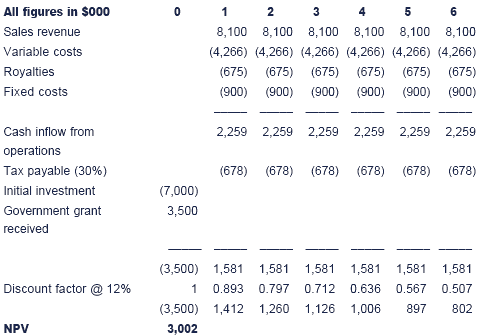
Alternatively, an annuity approach can be taken:

(b)(i)

(ii)
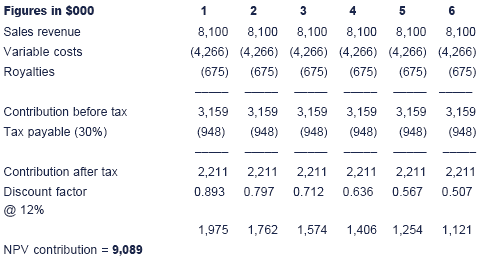
Or using annuities:

Sensitivity = NPV / PV of contribution = 3002/9089 = 33%
i.e the annual contribution would have to decrease by 33% before the project was rejected.
(c) Factors that should be considered by the directors of JDL include:
- How the cash flows are estimated. How accurate they are requires detailed consideration.
- The cost of capital used by the finance director might be inappropriate. For example if the EF solar panels proposal is less risky than other projects undertaken by JDL then a lower cost of capital should be used.
- How strong is the EF brand name? The directors are proposing to pay royalties equivalent to 8% of sales revenue during the six years of the anticipated life of the project. Should they market the EF solar panels themselves?
- Would competitors enter the market and what would be the likely effect on sales volumes and selling prices?
N.B: Only three factors were required.
(d)Benchmarking is the use of a yardstick to compare performance. The yardstick for benchmarking is based on best in class.
A major problem facing the management of JDL Ltd lies in theaccessing of information regarding the activities of a competitor firmthat may be acknowledged to display best practice. Internal benchmarkingi.e. using another function within the same firm as the standard canhelp in the avoidance of the problems of information access, but thatclearly limits the scope of what can be achieved. The most commonapproach is process benchmarking, where the standard of comparison is afirm which is not a direct competitor but is best in practice for aparticular process or activity.
The objective is to improve performance. This is best achieved bymeans of the sharing of information which should prove of mutualbenefit to both parties to the benchmarking programme. As a result ofreceiving new information each party will be able to review theirpolicies and procedures. The very process of comparing respective pastsuccesses and failures can serve as a stimulus for greater innovationwithin each organisation.
To evaluate the performance JDL they need to establish a basisfor targets which reflects the performance of an organisation whichdisplays 'Best Practice'. As a direct consequence of a comparison ofexisting standards with the 'Best Practice' organisation, managers canfocus upon areas where improvements can be achieved and evaluatemeasures to help attain those improvements.
A principal benefit that will be derived by JDL Ltd as a resultof undertaking a successful programme of benchmarking will be theidentification of areas where cost savings are possible. Hence thelevels of cost of sales and operating expenses can be reduced leading toincreased profitability.


 Test your understanding 6
Test your understanding 6


 Test your understanding 7
Test your understanding 7

The company has high receivables, low inventories, a low cash balance and high trade payables.
The philosophy is to chase sales by offering lax trade credit tocustomers, while attempting to maintain adequate liquidity by takingextensive credit from suppliers.
This is a risky policy since it involves the risk of:
- Long-standing receivables balances going bad
- Discouraging potential customers since low inventory means an increased risk of goods being out of stock.
The low cash balance means that unexpected expenditures cannot bepaid for out of cash. Specific funds would have to be organised.
The high trade payables will upset the suppliers; they may even stop supply until the balance outstanding is paid.


 Test your understanding 8
Test your understanding 8
Report on the comparative financial performance of WSS and EA.
(i)Summary of financial ratios
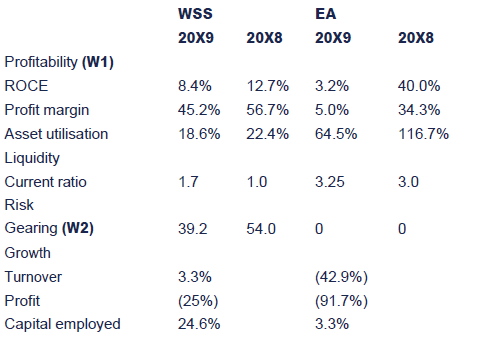
(ii) Comments on ratios
Both companies have shown a significant fall in profits. The ratiosshow that this is due to both a reduction in margins and falling assetutilisation. Capital employed has grown (especially for WSS) and it maybe that this extra investment needs more time to generate additionalprofit.
EA has witnessed a dramatic reduction in sales. Costs seem to belargely fixed as these have only fallen by 17%. Turnover for theregulated monopoly appears to be more stable.
Financial risk (gearing) is high in WSS (although no comparisonswith similar companies are available), but the gearing ratio has fallenin the year. High gearing magnifies the effect of volatile turnover onprofit. Although it would seem EA has high operating gearing (fixed tototal costs), this is somewhat compensated by the fact that it has nofinancial gearing.
Liquidity for both companies has improved, although no benchmarks against respective industry averages are available.
(iii)Limitations
Accuracy of the figures – are the two years under review representative?
Short versus long term – longer-term trends would be useful.Certain events in 20X9 (i.e. expenditure on fixed assets) will reduceshort-term performance but fuel longer-term growth (and profit).
The two companies cannot really be compared – one is aregulated monopoly, the other has to compete in a competitive marketbased on the perception of its products, quality and value for money.
As such, comparison may be better carried out using industry benchmarks.
Profitability can only be fully appraised when compared againstrequired returns of the shareholders. This, in turn, reflects theperceived risks they take when investing in each company. This may belower for a regulated monopoly, and thus ROCEs lower, although themonopoly does have a higher level of gearing.
Workings
(1)Profitability ratios (20X9 shown)

- Note: profit before interest used as the objective is to measureinternal efficiency rather than return to external shareholders.
(2)Gearing ratios (20X9 shown)


|
Created at 5/24/2012 4:29 PM by System Account
(GMT) Greenwich Mean Time : Dublin, Edinburgh, Lisbon, London
|
Last modified at 5/25/2012 12:55 PM by System Account
(GMT) Greenwich Mean Time : Dublin, Edinburgh, Lisbon, London
|
|
|
|
 |
Rating
:
|
 Ratings & Comments
(Click the stars to rate the page) Ratings & Comments
(Click the stars to rate the page)
|
 |
Tags:
|
|
|
|
|